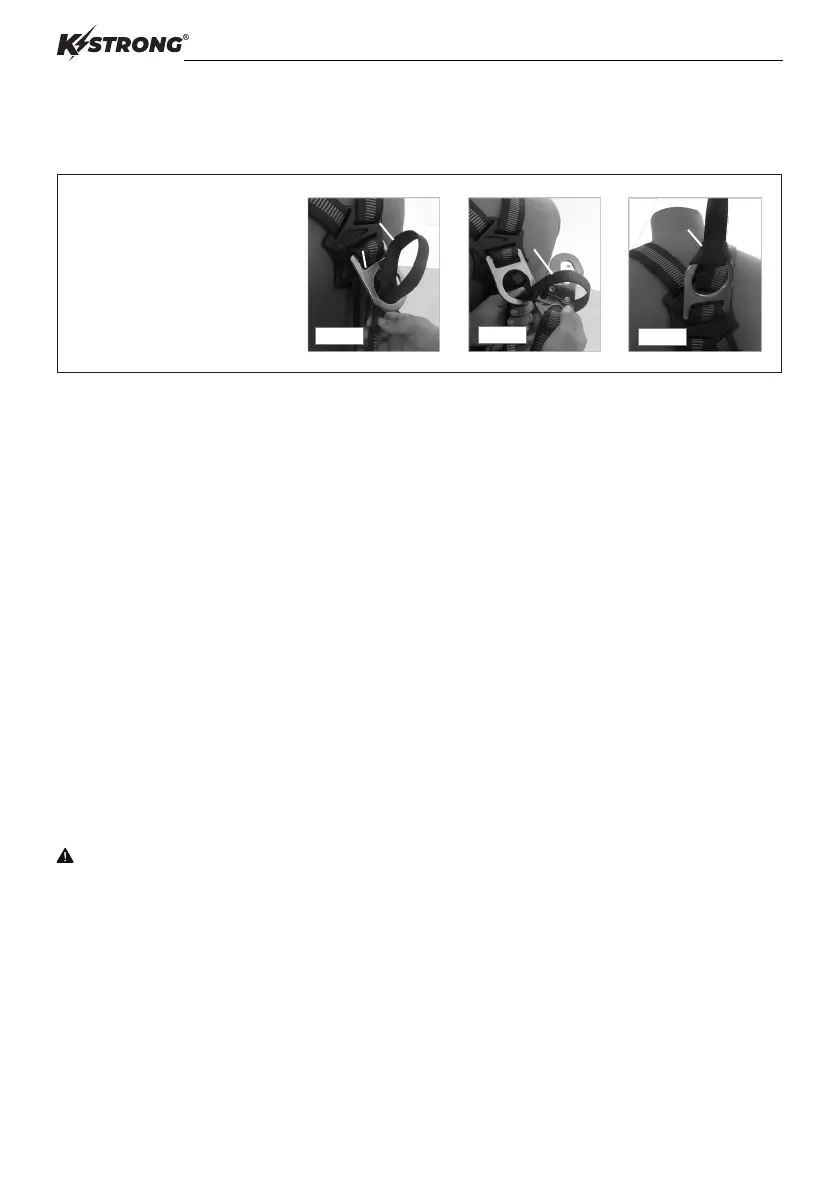KStrong UFL201101 handleiding
Handleiding
Je bekijkt pagina 5 van 12

5
CONNECTING LOOP OF LANYARD TO HARNESS D-RING
Some lanyards are provided with a web loop at one end and connector at the other end. This web loop is connected to the dorsal attachment
D-ring of a harness in the following manner:
CONNECTING SUBSYSTEMS:
Use only those connecting subsystems (self-retracting lifeline, lanyard, rope grab and lifeline, cable sleeves) that are suitable for your
application. See subsystems manufacturer’s instructions for more information. Some harness models have web loop connecting points. Do
not use snap hooks to connect to the web loop. Use a self-locking carabiner to connect to a web loop. Ensure that the carabiner is connected
in such a way that it close not lead to cross-gate load. Sometimes lanyards may be sewn directly to the web loop forming a permanent
connection. Do not make multiple connections onto one web loop.
RESCUE PLAN:
A rescue plan should be well documented and in place before performing work at height. The rescue operation must be performed by trained
and competent personnel only. The rescue expert team should supervise the rescue operation performed. It is also advised to work in pairs
while working on the site.
ENVIRONMENTAL HAZARDS:
It is important to take additional precautions while using this equipment in the presence of any environmental hazards so as to prevent injury to
the user or damage to the equipment.
Environmental hazards may include the following, but are not limited to:
• Chemicals
• Extreme Temperatures
• Corrosive Environments
• Gases
• High Voltage Power Lines
• Sharp Edges
• Moving Machinery and Vehicles
Please contact KStrong for use of this equipment in the presence of any environmental hazard.
WARNING
This equipment is not designed to be used in high temperature environment. It is important to protect this equipment when using near activities
like welding or metal cutting. Hot sparks may cause damage to this equipment or burn it. Contact KStrong with any questions regarding the details
on use of this equipment in high temperature environment.
ANCHORAGE STRENGTH:
The application type determines the anchorage strength requirement. As per ANSI Z359.1 the necessary anchorage strength for the following
applications is listed below:
• Fall Arrest: As per OSHA 1926.500 and 1910.66: anchorages that are used for attachment in Personnel Fall Arrest Systems (PFAS)
shall be independent of any anchorage being used to support or suspend platforms. They should be capable of withstanding a
minimum load of 5000 lbs. (23 kN) per user attached, or should be designed, installed and used as part of a complete PFAS which
maintains a safety factor of at least two. Rating of the anchorage should always be done under the supervision of a qualied person.
Information regarding designing the fall protection systems are available with KStrong.
Step 1. Insert Lanyard Web Loop
through Web Loop or D-ring on
harness.
Step 2. Insert opposite end of lanyard
through the Lanyard Web Loop.
Step 3. Pull the Lanyard through the
connecting Web Loop so as to
secure a tight knot.
Lanyard Web Loop
Tight
knot
Opposite
end of
Web Loop
Harness D-ring
STEP- 1
STEP- 2
STEP- 3
Bekijk gratis de handleiding van KStrong UFL201101, stel vragen en lees de antwoorden op veelvoorkomende problemen, of gebruik onze assistent om sneller informatie in de handleiding te vinden of uitleg te krijgen over specifieke functies.
Productinformatie
| Merk | KStrong |
| Model | UFL201101 |
| Categorie | Niet gecategoriseerd |
| Taal | Nederlands |
| Grootte | 1674 MB |







